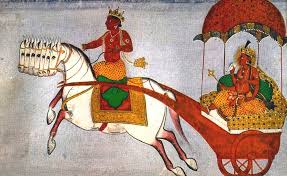Arun, the charioteer of the lamp of the world (i.e. the sun) and brother of Garuda, the king of the birds became a cripple on account of his past actions. (Dhanasari Trilochan, p. 695) Aruna was the son of Kashyapa (Brahma’s son) by his wife Vinata. Kashyapa had two wives: Vinata and Kadru. Having been pleased by their services, he granted them boons. Kadru was to be blessed with one thousand naga (serpent) sons and Vinata with two powerful sons. Kadru laid one thousand eggs and Vinata two.
After five hundred years, Kadru had one thousand sons. Vinata’s eggs were not mature as yet, but she became so much impatient that she broke open one of her eggs and a half-developed child, Aruna, came out. After another five hundred years, the other egg of Vinata, which became fully developed, hatched itself and her second son Garuda was bom. On his pre-mature birth, Aruna cursed his mother to live as slave of Kadru till the birth of her second son.
After pronouncing the curse, Aruna rose to the sky and on the advice of Brahma, became the charioteer of sun-god, so that by standing before the god, the intensity of his heat may be reduced. It is said that Aruna broke the legs of some birds in one of his previous births, therefore in pursuance of the law of Kanna, he became a cripple as the brotner of Garuda. One cannot escape the punishment of previous actions.
References :
1. Kohli, Surindar Singh, Dictionary of Mythological References in Guru Granth Sahib, 1993
Aruna
The Guru Granth Sahib, revered as the eternal guide in Sikhism, is a scripture that seamlessly blends spiritual truths with cultural and mythological symbols. These references serve as metaphors to convey profound teachings and encourage seekers to rise above worldly attachments toward union with the Divine. Among such references is Aruna, a figure drawn from Hindu mythology, who embodies themes of illumination, duty, and divine purpose.
In Hindu mythology, Aruna is the charioteer of the sun god Surya, often depicted as guiding the celestial chariot across the heavens. Aruna symbolizes the light of dawn and is associated with the pursuit of enlightenment. His role as a charioteer signifies steadfast duty and alignment with the cosmic order, reminding humanity of the importance of fulfilling one’s responsibilities with humility and devotion.
While the Guru Granth Sahib does not explicitly focus on the tale of Aruna, it often invokes the symbolism of light and sunrise as metaphors for spiritual awakening and divine grace. The scripture teaches that just as the dawn dispels the darkness of night, divine wisdom illuminates the soul, guiding individuals on their spiritual journey. References to figures like Aruna highlight the importance of aligning oneself with divine will and embracing one’s purpose with selflessness and dedication.
The Guru Granth Sahib transforms mythological symbols into universal truths that transcend religious boundaries. By reimagining figures like Aruna, the scripture fosters inclusivity and emphasizes the interconnectedness of all spiritual traditions. It calls upon seekers to recognize the light within themselves and share it with others through acts of kindness, humility, and devotion.
In conclusion, the reference to Aruna in the context of Guru Granth Sahib underscores themes of enlightenment, duty, and selfless service. It inspires individuals to rise above ego, embrace their divine purpose, and seek unity with the Creator. This metaphorical exploration enriches the scripture’s timeless teachings, making them relevant to seekers of all backgrounds.



